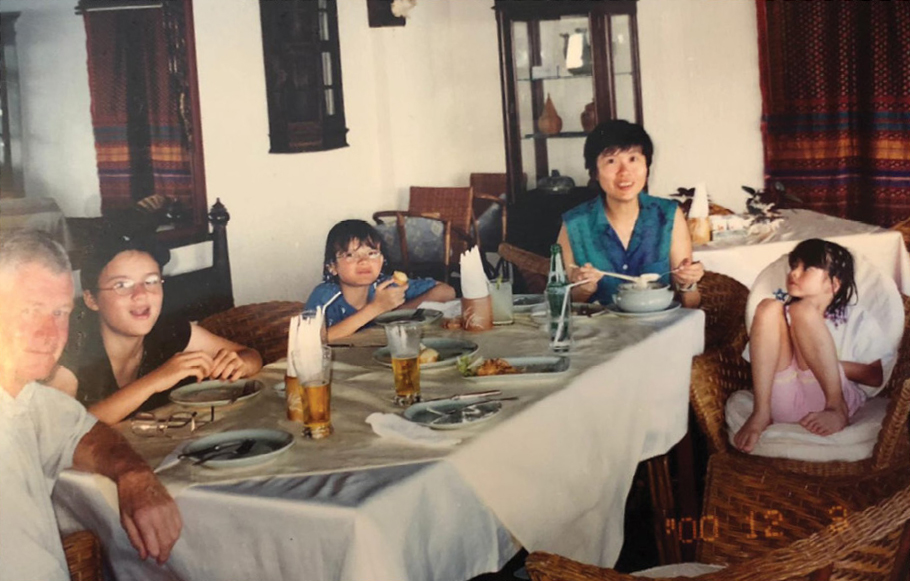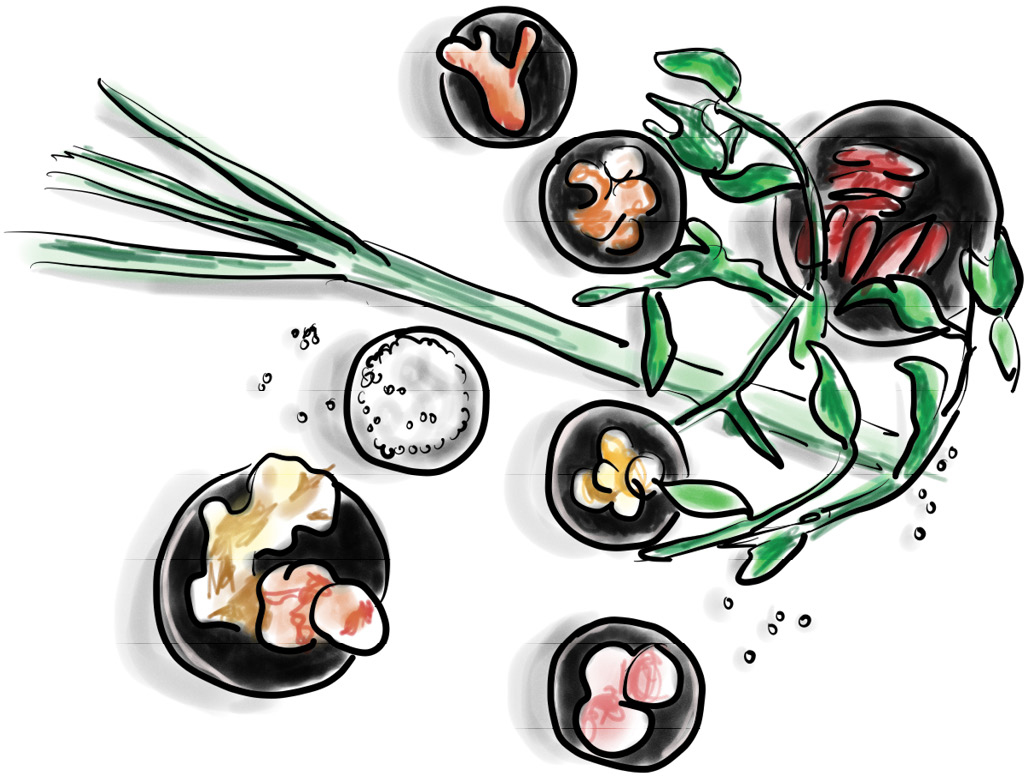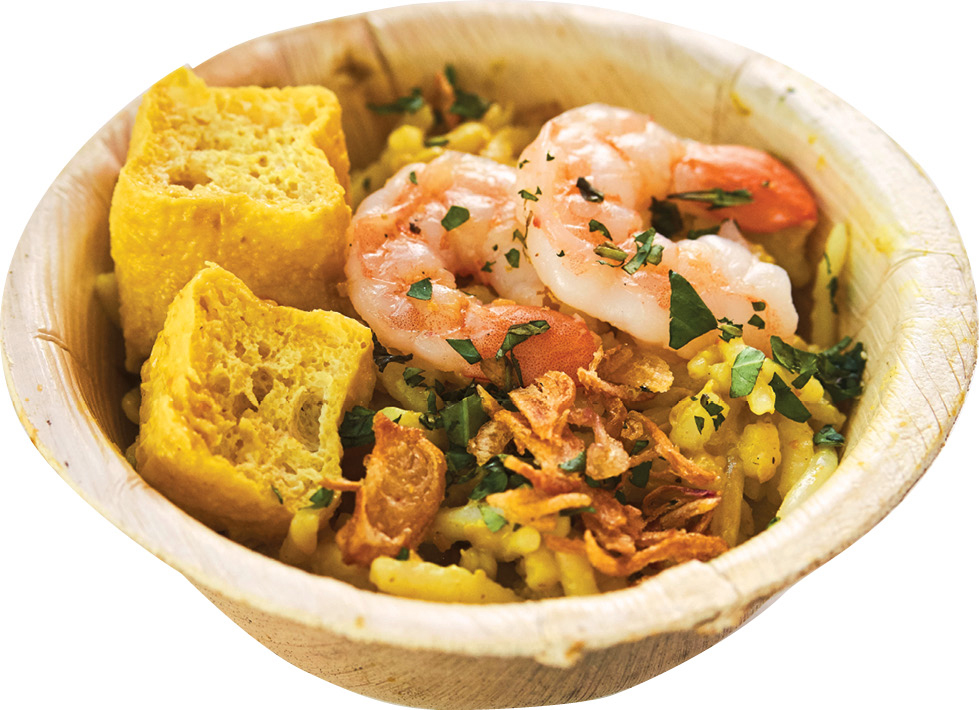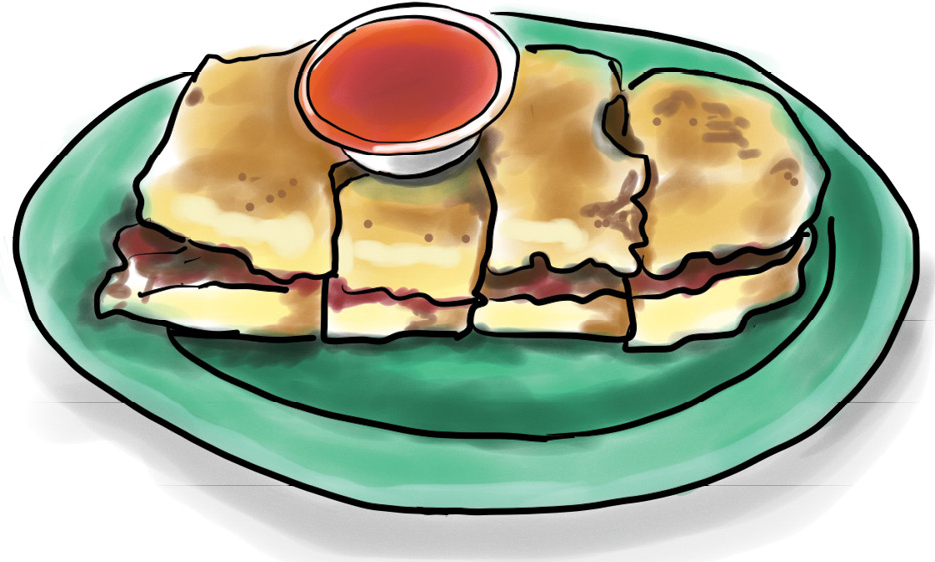
Amy Pryke
NATIVE NOODLES
38
SINGAPORE
A recent graduate of Columbia Business School, Amy Pryke is on a mission to create a new kind of fast-casual Singaporean noodle shop in NYC. Her Queens Night Market tent is her testing ground; the famous hawker centers of Singapore, her inspiration.
“The hawker centers are basically semi-outdoor, huge communal dining spaces where you can find at least fifteen to twenty-five different kinds of cuisines. Usually each stand specializes in one or two things, so it could be a laksa noodle stand, like what I’m selling at Queens Night Market, or it could be like a grilled meat on a stick—what we call satays. Each one specializes and you can basically spend like two to four dollars for a dish and then share with like a whole table of people. Most working-class, or no . . . most Singaporeans in general would eat at least one meal a day at a hawker center. There are many—every neighborhood has one.
How you refer to Caucasians in Singapore commonly is ang-moh, which means ‘redhead.’ It’s also how a lot of Singaporeans would refer to me actually, if they didn’t know that I spoke Mandarin, and I tried to order, they’d be like, Whoa, why is that ang-moh speaking Mandarin? English is my first language—all Singaporeans are fluent in English at least, because it’s our language of instruction—and then you usually take a mother tongue, which tends to be the language your mother speaks. So in my case, my mom is Chinese, so I spoke and learned Chinese in school.
Ever since graduating from NYU, I had made decisions based on what outwardly looked nice, to check the box of OK, yeah, I’m working in a big financial services company that will sponsor my visa—that’s great. I checked that box. Then the next step was OK, now I’ve worked in this big financial services company; what’s even more prestigious? It’s moving to a company that’s hyped as one of the top places to work, so I went to BCG [Boston Consulting Group] after, and that was a personal accomplishment. But once I was there I realized this isn’t actually what I want to do. And there’s kind of a limit of things you can do to check the boxes.
I was in my consulting job and thinking, How do I do something different now? I wasn’t ready to leave New York, and as an immigrant you can’t just quit your job—you immediately lose your status and become an ‘unlawful presence’—so I was thinking, How do I buy some time and figure out what I’m going to do next? And I knew it was going to be related to the food world, because someone had given me the advice to know your passion to figure out what you should try and pursue. Like if you have half an hour at lunch, what would you be reading, what would you be thinking about? And for me it was always related to the restaurant world and hospitality. I guessed business school would be a good way to plan out my next steps. . . . I wrote my essay on opening a restaurant, which is not very common for business school, and got in.
I got the laksa recipe from my nanny, Susila, who lived with us since my little sister was born—so maybe almost twenty years. She cooked for our family and is like family to us. She’s actually from Sri Lanka, and we still have a very good relationship with her. We visited her family in Sri Lanka, and so it’s not so uncommon for families in Singapore to have live-in helpers like nannies. She was an excellent cook.

Family dinner during a summer vacation at the beach: Pryke Family meals were nonnegotiable—they ate dinner together no matter what!
Since I was little I would follow her to the market, and she had these amazing relationships with all the stall owners, and they would save the best parts of meat and the freshest vegetables for her. She learned a lot of cooking from my grandmother, too, and watched a ton of cooking shows—like she loved Jamie Oliver. She developed a repertoire of Singaporean recipes that we would eat at home, and one of them was this laksa dish. When I went home a few summers ago, I learned it from her, and I kept it in notes on my phone. I also did some research on famous hawker center stalls’ recipes and adapted my own version, refined by testing with friends.
“SINGAPOREAN CUISINE HAS AT LEAST EIGHT TO TEN DISTINCT NOODLE STYLES, SO I STARTED WITH LAKSA, AND A RECIPE WHICH TO ME ENCAPSULATES A MULTI-ETHNIC SOCIETY.”
My first time ever selling food commercially was April 2019 at the Queens Night Market, with the long-term goal of opening a fast-casual restaurant to create a scalable model, offering eight to ten noodle dishes that are to some extent customizable. Singaporean cuisine has at least eight to ten distinct noodle styles, so I started with laksa, and a recipe which to me encapsulates a multiethnic society. We have Chinese, Malays, Indians, and what you call ‘others,’ which I guess I would fall into, whether you’re mixed race or Eurasian—and our food is a blend of all of those cultures.
My parents initially felt like, Why are you choosing the hard way? What are you doing with your expensive degrees? It’s definitely a thing for Asian parents to overcome: first, entrepreneurship, then, even worse, in the food business. So it’s a double whammy. I want to show my parents that I am serious about it and I have the grit to do it. A tough industry to be in, with not a lot of return, at least monetarily.
I struggle with feeling that I’m letting them down with my decision. But ever since the Night Market, and them seeing how I’ve done it myself, seeing that it’s going well, my mom has been so supportive, she shares everything on her own Facebook page. She got even more likes than me, when she shared my first Queens Night Market post!”
LAKSA NOODLES
Singaporean laksa noodles are thick rice noodles swimming in a spicy, creamy coconut broth, usually garnished with shrimp or chicken, fried tofu puffs, and rau ram (Vietnamese cilantro). When Amy was growing up, her nanny would make the broth and noodles and lay out a big spread of garnishes, allowing each family member to customize their own bowl of laksa noodles. Slurping noodles around the dinner table with her family is her fondest and most indelible food memory.

Makes 4 servings
REMPAH (SPICE PASTE)*
1 cup (240 ml) vegetable oil
1 pound (455 g) shallots, peeled and chopped
7 dried medium-hot red chiles (such as Chinese “facing heaven chiles”), halved and seeded
6 ounces (170 g) dried shrimp
6 garlic cloves, peeled
7 candlenuts
2 tablespoons dried shrimp paste (belacan)
2 thumb-size pieces fresh turmeric, peeled, or 1 tablespoon ground turmeric
1-inch (2.5 cm) piece galangal, peeled and sliced
1-inch (2.5 cm) piece peeled fresh ginger, sliced
4 lemongrass stalks (tender white part only), or 1 tablespoon plus 1 teaspoon ground lemongrass
1 tablespoon plus 1 teaspoon granulated sugar
1 tablespoon salt
2 teaspoons curry powder
LAKSA NOODLES
8 shrimp (preferred size)
1 pound (455 g) thick rice noodles (lai fun)
1 tablespoon vegetable oil
⅔ cup (85 g) dried shrimp, diced
2½ tablespoons rau ram (Vietnamese cilantro) chiffonade, optional**
2½ teaspoons granulated sugar
⅔ cup (150 ml) coconut milk, plus more if desired
5 pieces fried tofu (“fried tofu puffs”), halved
Handful of bean sprouts
Fish sauce or salt
Crispy fried shallots, optional
1. To make the rempah, blend all the ingredients in a food processor into a smooth paste.
2. To make the laksa noodles, bring a medium pot of water to a boil and blanch the raw shrimp until pink and just cooked, about 30 to 45 seconds. Drain, peel, and set aside.
3. Bring a large pot of water to boil, add the noodles, and cook according to package directions. Drain and set aside.
4. Heat the oil in a large skillet over medium-high heat and stir-fry the dried shrimp until fragrant, about 30 seconds. Reduce the heat to medium-low and add 2 tablespoons of the rau ram, if using, and ¾ cup (170 g) of the rempah. Cook for about 20 minutes, stirring occasionally so the bottom does not burn.
5. Add the sugar and stir to combine. Add the coconut milk and turn the heat to medium, bringing to a light boil. Add the tofu puffs and bean sprouts and stir to combine for 1 minute. Add the blanched shrimp and cooked noodles and stir until well incorporated. Remove from the heat. Add the fish sauce to taste and mix well.
6. If you prefer a runnier soup, add more coconut milk. Serve in four bowls and garnish with the remaining rau ram and the crispy shallots, if using.

* You can use store-bought Laksa paste (common brands are Por Kwan or Tean’s) instead of making the rempah spice paste from scratch, in which case you would start at step 2.
** If too difficult to find, the rau ram can be omitted.
*** The recipe for rempah makes more spice paste than is called for in the recipe. Excess will keep in the fridge for a month or in the freezer for 3 months. It works well with any seafood or vegetable stir-fry; simply heat equal parts oil and rempah over medium heat before stir-frying. Rempah is also a great marinade for fish.
ROTI JOHN
Omelet Sandwiches
Roti means bread in Hindi, and John was a common form of address for any Caucasian man in Singapore. Roti John embodies the melting-pot cuisine of Singapore. It is a toasty sandwich of minced meat and onions, wrapped in eggs, and slathered with a ketchup-based sauce. Amy considers it the perfect breakfast sandwich, although you can enjoy it anytime you feel like having an indulgent sandwich.
Makes 1 serving
SPICY KETCHUP
2 tablespoons ketchup
2 tablespoons sriracha
1 tablespoon granulated sugar
ROTI JOHN
⅓ large baguette or 1 hero roll (about 8 inches/20 cm long)
1 tablespoon plus 1 teaspoon canola or grapeseed oil
4 ounces (110 g) minced lamb, beef, or beef/lamb mix
½ teaspoon ground cumin
3 garlic cloves, minced
½ small white or yellow onion, sliced
3 eggs
1 tablespoon sambal oelek chili paste
¼ teaspoon salt
Pinch of ground black pepper
1. To make the spicy ketchup, combine the ketchup, sriracha, and sugar with 2 tablespoons water in a bowl and set aside.
2. To make the roti John, split the bread lengthwise but do not cut all the way through, leaving a small hinge like a hot dog bun. Lightly oil a nonstick skillet with 1 teaspoon of the oil and toast the inside of the baguette by pressing down with a spatula until lightly browned, about 2 minutes. You can also toast the bread in your oven for 2 minutes on the broiler setting.
3. Combine the meat and cumin in a bowl and set aside.
4. Heat the remaining 1 tablespoon oil in the skillet over medium heat and fry the garlic until fragrant, about 30 seconds. Add the onions and cook over low heat until translucent, about 6 minutes. Turn the heat to medium. Add the meat and stir-fry until cooked through, about 6 minutes.
5. Crack the eggs into a bowl, beat lightly, then add the sambal oelek, salt, and pepper, and mix well.
6. Pour the eggs into the skillet, covering the meat. When the edges of the egg just start to firm up, after about 30 seconds, press the bread face-down lightly onto the mixture with a spatula for 2 to 3 minutes as the eggs continue to cook. The bread will absorb much of the egg mixture.
7. Flip the bread along with the omelet with a spatula and cook for about 1 minute. If the eggs are not cooked to desired doneness, flip the baguette back and cook until done.
8. Transfer to a plate and spread some ketchup in the center. Close the sandwich, slice into four pieces, and serve.
